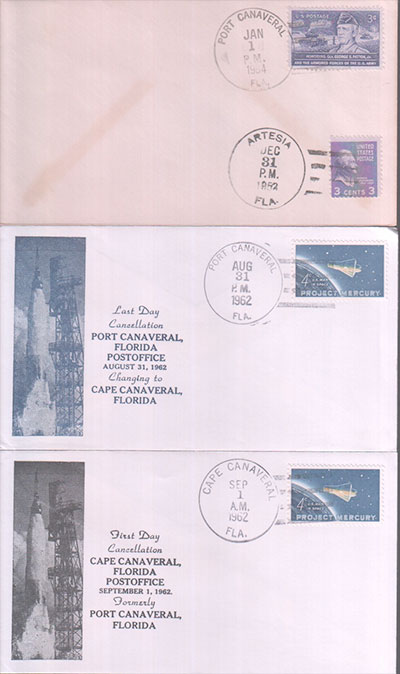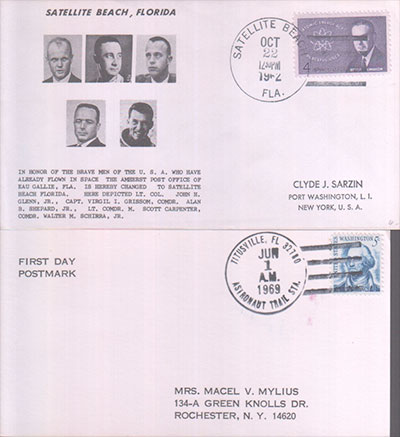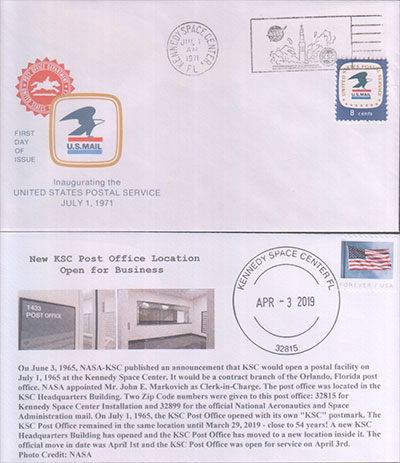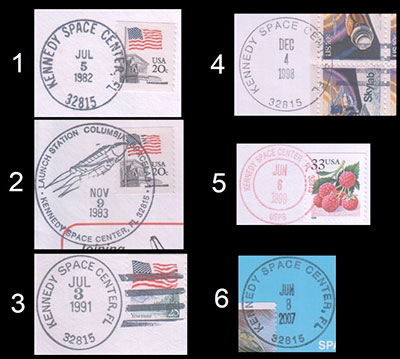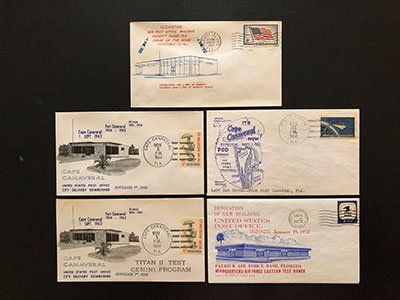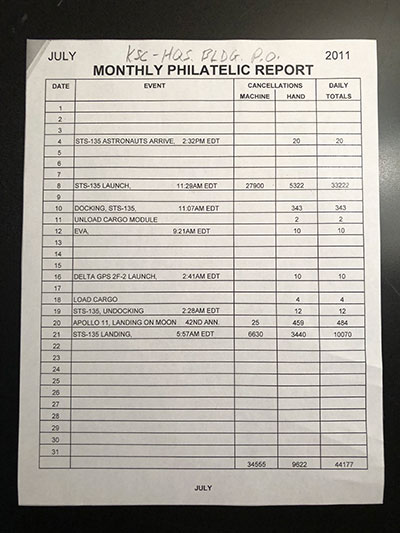Ken Havekotte
Member Posts: 3378
From: Merritt Island, Florida, Brevard
Registered: Mar 2001
|
 posted 07-01-2020 10:50 AM
posted 07-01-2020 10:50 AM
   
For us astrophilatelists, collectors of postal covers and stamps, it would be 55 years ago to this day (July 1) that the U.S. Postal Service (USPS) established mail service at NASA's John F. Kennedy Space Center (KSC) in Florida.With the beginning of Florida's rocket and space efforts during the 1950's, the closest postal facility nearby the missile and rocket firing test range was a small town settlement of Artesia, located on the Cape peninsula near the present south #1 gate of the now present Cape Canaveral Air Force Station (CCAFS). There had been a small post office set up for basic postal services from 1891 to 1953. In January 1954, Artesia had a name change to Port Canaveral, which would later become Cape Canaveral in 1962. Artesia was less than 5 miles away from the first built Cape-rocket oceanside launch site (Pad 3) in July 1950 where the twin Bumper rockets flew from. Before Artesia had changed to Port Canaveral, the small settlement was the closest postal site to the Bumper V-2's, and to other nearby Cape-area launch pads that were used for the Lark, Matador and Snark winged missiles, Bomarc, and the very first Redstone vehicle all throughout the early 1950's before NASA had been created. During those early years of pioneering space achievements, much of the Air Force, other military, and aerospace contractor mail had been processed at various postal locations. Most of the Air Force and other military mail was processed at Patrick Air Force Base (PAFB), located about 16 miles south of the Cape air force station, and even to this day. Much of the early space business contractor mail had been handled in their work postal areas of Port Canaveral, Titusville to the north-west, Cocoa/ Rockledge in the south, and further south in the Melbourne/Eau Gallie area, all within Brevard County, during the 1950's and 60's. 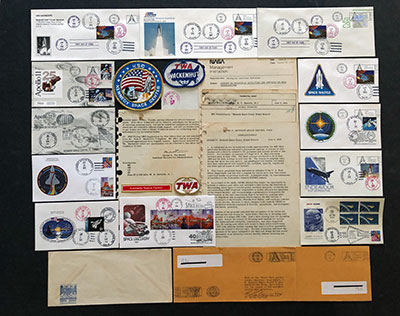 When NASA was first established in 1958, a Launch Operations Center (LOC) group had been organized as a branch of NASA's Marshall Space Flight Center (MSFC) in Huntsville, Alabama, in 1960. The LOC, now separate from MSFC, was created as an independent NASA field center located on Merritt Island, Florida. It wasn't until November 1963 that President Johnson designated the facilities of the LOC, Station #1 of the Atlantic Missile Range, as NASA's John F. Kennedy Space Center (KSC), covering more than 200 square miles of Central Florida's eastern coastal area. As the Florida space center grew each year, KSC-NASA wanted their own postal facility to accommodate a work force in excess of 20,000+. The volume of incoming and outgoing KSC mail all throughout the 1960's continued to increase along with the volume of registered, certified, insured, and other special types of mail. The new workload statistics were presented to the U.S. Post Office Department in the fall of 1964 and prompted a detailed study of KSC's growth and means of effectively serving its postal requirements. This study coincided with the postal department's overall study of its mail and distribution system based on zip code uses and increased mechanization. As a result of the studies, the Office of the Postmaster General established a contract postal facility on the space center itself as a branch of the Orlando post office, with two zip codes assigned to KSC. The official NASA mail processed at KSC would have a zip code of 32899 while another zip code of 32815 was assigned for use by other personnel and customers of the branch office as part of the center's Installation Support Directorate. The new postal station, located on the east wing of the KSC Headquarters building's first floor, began operations on July 1, 1965, as a "contract branch" of the Orlando/Florida Post Office Department, operated by Trans World Airlines, Inc. (TWA), a support contractor for the space agency at Kennedy Space Center. As a sidebar, by the time that our nation's first Gemini astronauts were going into space, NASA had been receiving between 600 to 700 letters per day. Prior to GT-3, the first crewed Gemini flight, a normal run of mail (in most categories) was about 150 a day, with almost 10% of those letters from foreign countries. By the fall of 1965, the average daily delivery of U.S. mail bags was 40+ per day, sometimes reaching nearly 1,000 pieces of mail a day. The establishment of a new postal unit on KSC grounds helped to better handle, manage, and process increasing volumes of incoming and outgoing letters, most of it fan mail, that had not been experienced beforehand with such large numbers. The original post office station had been in the same location from July 1, 1965, to April 1, 2019, when the old KSC Headquarters building was no longer in use by space center employees. Last year, all of the center's postal equipment, facilities, and operations were moved over to a new seven-story headquarters building, also known as the NASA Central Campus Headquarters Building, only a few yards away from the old four-story structure. But there was one piece of equipment not moved over to the new building, and that was one of the original mechanical die-hub cancel machines. It had been used on countless numbers of machine-applied postal cancellations all throughout the shuttle program years, probably since the late 1970's, in addition to other numerous space cover events. It had been trucked over to the main Titusville postal facility along U.S. 1 for either storage on a non-use basis, re-deliver to another postal facility (not for use), or later disposal of. An earlier KSC machine canceler from the 1960/70's had been replaced by a second machine, which is believed to be the same replacement device used for the shuttle program years. 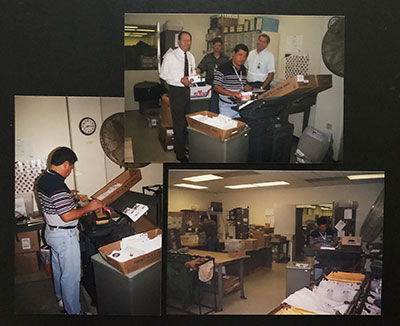 Above: The above photos are of the KSC post office on Oct. 30, 1998. It was one the biggest space cover cancelling days in the shuttle program history of the space center since the first shuttle launch in 1981. The single cancellation machine can be seen in operation while processing STS-95/Discovery launch day covers provided by SpaceCoast Cover Service. There's also a new company operating the current KSC post office contract these days. Outbidding the Government Contracting Resources (GCR) firm nearly 7 years ago, the Anthony Wayne Rehabilitation Center (AWRC), its Post Masters Mail and Print Services, took over the space center mail and distribution services on a 5-year contract basis. The firm-fixed price contract began Oct. 1, 2013, and included courier services for 92 buildings and 670 mail stops, as well as operating several mail rooms at KSC. AWRC is a not-for-profit company that provides high quality services with exceptional customer care, while also providing job opportunities for people with disabilities, including service-disabled veterans. Most of the GCR postal workers are no longer working in the new spacious post office of the 18 or so employees now assigned there by the new contract provider. 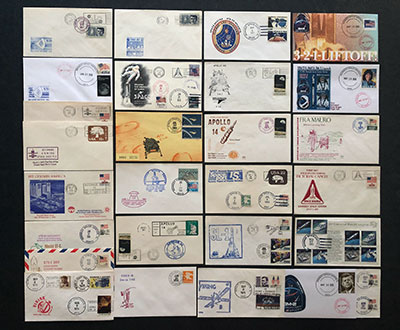 Depicted here are about 30+ different postal strike impressions, both hand and machine cancel generated, from the 55-year-old postal history of NASA's only postal station at the Kennedy Space Center from 1965 to present day. Not included, though, are various first day issue strikes, pictorial cancels, meter uses, and roller bar impressions. Just about every KSC cancel type should be included in this pictorial depiction, including other KSC hand cancel devices that were not housed at Kennedy, but at authorized nearby postal stations to accommodate other mail and bulk philatelic requests by non-space center employees. Please feel free, though, to share any other postal cancel types not seen in this posting. |














